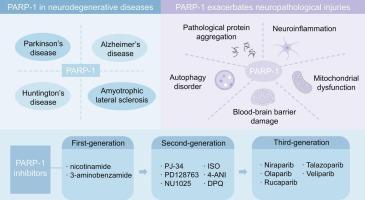Roles and therapeutic potential of PARP-1 in neurodegenerative diseases
IF 5.6
2区 医学
Q1 PHARMACOLOGY & PHARMACY
引用次数: 0
Abstract
Poly(ADP-ribose) polymerase 1 (PARP-1) was first discovered in the 1960 s, and over the past few decades, there has been growing evidence that PARP-1 plays a key role in neurodegenerative diseases such as Parkinson’s disease, Alzheimer’s disease, Huntington’s disease, and amyotrophic lateral sclerosis. With DNA damage detection and repair as its main function, PARP-1 is activated by regulation in the early stages of neurodegenerative diseases, quickly and effectively repairs mild DNA damage, and protects nerve cells from death. However, as the disease progresses, severe DNA damage causes PARP-1 to overactivate, resulting in neuronal cell death, including apoptosis, necrosis, and parthanatos, further exacerbating the disease progression. PARP-1 is also involved in the pathological process of neurodegenerative diseases, such as pathological protein aggregation, neuroinflammation, mitochondrial dysfunction, autophagy disorder, and damage to the blood–brain barrier. According to a large number of studies, PARP-1 inhibition has shown great therapeutic potential for neurodegenerative diseases, and the development of PARP-1 inhibitors has received increasing attention. Here, we review the role of PARP-1 in the process of neurodegenerative diseases and summarize the latest research progress and application of PARP-1 inhibitors in neurodegenerative diseases.

PARP-1在神经退行性疾病中的作用和治疗潜力。
聚(adp -核糖)聚合酶1 (PARP-1)于20世纪60年代 首次被发现,在过去的几十年里,越来越多的证据表明PARP-1在神经退行性疾病如帕金森病、阿尔茨海默病、亨廷顿病和肌萎缩性侧索硬化症中起着关键作用。PARP-1以DNA损伤检测和修复为主要功能,在神经退行性疾病早期通过调控激活,快速有效修复轻度DNA损伤,保护神经细胞免于死亡。然而,随着疾病进展,严重的DNA损伤导致PARP-1过度激活,导致神经元细胞死亡,包括凋亡、坏死和旁咽下物,进一步加剧疾病进展。PARP-1还参与神经退行性疾病的病理过程,如病理性蛋白聚集、神经炎症、线粒体功能障碍、自噬障碍、血脑屏障损伤等。大量研究表明,PARP-1抑制在神经退行性疾病中显示出巨大的治疗潜力,PARP-1抑制剂的开发越来越受到重视。本文就PARP-1在神经退行性疾病发生过程中的作用进行综述,并对PARP-1抑制剂在神经退行性疾病中的最新研究进展及应用进行综述。
本文章由计算机程序翻译,如有差异,请以英文原文为准。
求助全文
约1分钟内获得全文
求助全文
来源期刊

Biochemical pharmacology
医学-药学
CiteScore
10.30
自引率
1.70%
发文量
420
审稿时长
17 days
期刊介绍:
Biochemical Pharmacology publishes original research findings, Commentaries and review articles related to the elucidation of cellular and tissue function(s) at the biochemical and molecular levels, the modification of cellular phenotype(s) by genetic, transcriptional/translational or drug/compound-induced modifications, as well as the pharmacodynamics and pharmacokinetics of xenobiotics and drugs, the latter including both small molecules and biologics.
The journal''s target audience includes scientists engaged in the identification and study of the mechanisms of action of xenobiotics, biologics and drugs and in the drug discovery and development process.
All areas of cellular biology and cellular, tissue/organ and whole animal pharmacology fall within the scope of the journal. Drug classes covered include anti-infectives, anti-inflammatory agents, chemotherapeutics, cardiovascular, endocrinological, immunological, metabolic, neurological and psychiatric drugs, as well as research on drug metabolism and kinetics. While medicinal chemistry is a topic of complimentary interest, manuscripts in this area must contain sufficient biological data to characterize pharmacologically the compounds reported. Submissions describing work focused predominately on chemical synthesis and molecular modeling will not be considered for review.
While particular emphasis is placed on reporting the results of molecular and biochemical studies, research involving the use of tissue and animal models of human pathophysiology and toxicology is of interest to the extent that it helps define drug mechanisms of action, safety and efficacy.
 求助内容:
求助内容: 应助结果提醒方式:
应助结果提醒方式:


